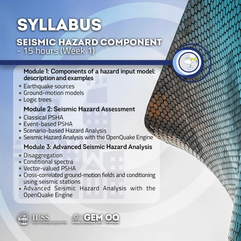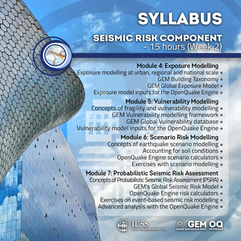GEM Models and OpenQuake Engine Training
May 5-16, 2025
EUCENTRE, Pavia, Italy

OVERVIEW
This course, part of the Doctoral Programme in Earthquake Engineering at IUSS Pavia, is organised by the Global Earthquake Model (GEM) Foundation, and aims to provide a comprehensive overview of state-of-the-art methods and models for seismic hazard, exposure, vulnerability and risk assessment, and their implementation within the OpenQuake Engine under a number of different use cases. The course will include both theoretical lectures and training sessions on how to use the OpenQuake Engine, from basic scenario analysis to advanced modelling of probabilistic seismic hazard and risk.
Speakers & Panelists
Session Title

Christopher Brooks
Seismic Hazard Modeller

Catalina Yepes Estrada
Exposure Development Lead

Alejandro Calderón
Exposure Research Lead

Kirsty Bayliss
Seismic Hazard Modeller

Anirudh Rao
Seismic Risk Modelling Lead

Marco Baiguera
Exposure Analyst

Manuela Villani
Senior Seismic Hazard Modeller

Al Mouayed Bellah Nafeh
Physical Vulnerability Lead

Marco Pagani
Head of Seismic Hazards

Martina Caruso
Seismic Risk Modeller
Agenda
Seismic Hazard Component - 15 hours (Week 1)
Module 1: Components of a hazard input model: description and examples
Earthquake sources
Ground-motion models
Logic trees
Module 2: Seismic Hazard Assessment
Classical PSHA
Event-based PSHA
Scenario-based Hazard Analysis
Seismic Hazard Analysis with the OpenQuake Engine
Module 3: Advanced Seismic Hazard Analysis
Disaggregation
Conditional spectra
Vector-valued PSHA
Cross-correlated ground-motion fields and conditioning using seismic stations
Advanced Seismic Hazard Analysis with the OpenQuake Engine
Seismic Risk Component - 15 hours (Week 2)
Module 4: Exposure Modelling
Exposure modelling at urban, regional and national scale
GEM Building Taxonomy
GEM Global Exposure Model
Exposure model inputs for the OpenQuake Engine
Module 5: Vulnerability Modelling
Concepts of fragility and vulnerability modelling
GEM Vulnerability modelling framework
GEM Global Vulnerability database
Vulnerability model inputs for the OpenQuake Engine
Module 6: Scenario Risk Modelling
Concepts of earthquake scenario modelling
Accounting for soil conditions
OpenQuake Engine scenario calculators
Exercises with scenario modelling
Module 7: Probabilistic Seismic Risk Assessment
Concepts of Probabilistic Seismic Risk Assessment (PSRA)
GEM’s Global Seismic Risk Model
OpenQuake Engine risk calculators
Exercises on event-based seismic risk modelling
Advanced analysis with the OpenQuake Engine
REGISTRATION
This course is currently full. Please sign up to our newsletter or social media channels to stay informed about future GEM training events.
EXHIBITION
LOCATION
HOTEL
TRANSPORTATION
RESOURCES
Conference resources for downloading
Videos
Gallery
Maps
Recording
Videos

Gallery
Maps
Recording




































